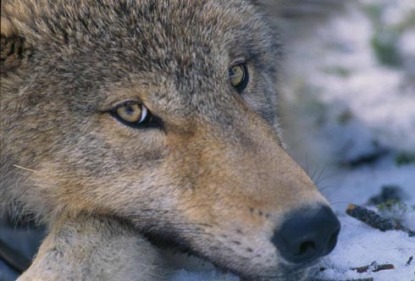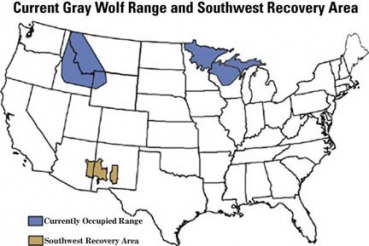Wolf Management
The Grey Wolf in Context
The Grey Wolf, Canis lupis, was listed as endangered under the federal Endangered Species Act in 1974, shortly after the Act was passed, as the animals were almost extirpated throughout the country in the 1930s. The wolf is still currently listed as an endangered species under the federal Endangered Species Act, but is listed under other classifications, such as threatened or removed from the list, in individual states. Wolves in Wyoming and the Southwest are designated as experimental, nonessential populations; wolves in Minnesota are listed as threatened; and in Alaska, Idaho and Montana as well as parts of Washington, Oregon and Utah, wolves are not listed under the Endangered Species Act at all. Currently, the Grey Wolf is known to occur in many US states, including Arizona, Colorado, Idaho, Michigan, Minnesota, Montana, New Mexico, Wisconsin and Wyoming.
Wolves travel in packs of 4-7 individuals and are highly loyal and social animals. On average, wolves will live to be 7-8 years old. They prey on large game animals such as elk, deer, moose and caribou, but will also eat beaver, rabbits and other small mammals.
Since the wolf was listed under the Endangered Species Act and policies to protect the wolf were instituted, the species has become stable and more widespread across the nation. One of the components of the protection efforts included reinstating wolf populations in Yellowstone National Park. After being exterminated in the area in the 1920s, wolves were reintroduced in the park in 1995, which sparked fierce debate over the role of the federal government in managing controversial species such as the wolf.
Defenders of Wildlife, an international organization that promotes wildlife conservation, states that the greatest threats to the Grey Wolf are conflicts with people over livestock losses, human encroachment into wolf territory, and people’s fear and misunderstanding about the species.
The Grey Wolf represents a number of different things in relation to different groups of actors. To wildlife conservationists, the wolf is a rallying point which can be used to further the goals of wisely managing wildlife. For farmers, the wolf is an opponent that destroys the life that the farmer tries to build. To hunters, the wolf is possibly the greatest challenge and conquest that the natural world can offer. For federal bureaucracies like the Fish and Wildlife Service, the wolf is an animal that must be studied, analyzed and managed. To tourists, the wolf provides the chance to see a top predator in its natural habitat, an opportunity that is increasingly rare in a world predominated by human civilization. The wolf transcends many social worlds, but is viewed differently in each context.
Since the wolf was listed under the Endangered Species Act and policies to protect the wolf were instituted, the species has become stable and more widespread across the nation. One of the components of the protection efforts included reinstating wolf populations in Yellowstone National Park. After being exterminated in the area in the 1920s, wolves were reintroduced in the park in 1995, which sparked fierce debate over the role of the federal government in managing controversial species such as the wolf.
Defenders of Wildlife, an international organization that promotes wildlife conservation, states that the greatest threats to the Grey Wolf are conflicts with people over livestock losses, human encroachment into wolf territory, and people’s fear and misunderstanding about the species.
The Grey Wolf represents a number of different things in relation to different groups of actors. To wildlife conservationists, the wolf is a rallying point which can be used to further the goals of wisely managing wildlife. For farmers, the wolf is an opponent that destroys the life that the farmer tries to build. To hunters, the wolf is possibly the greatest challenge and conquest that the natural world can offer. For federal bureaucracies like the Fish and Wildlife Service, the wolf is an animal that must be studied, analyzed and managed. To tourists, the wolf provides the chance to see a top predator in its natural habitat, an opportunity that is increasingly rare in a world predominated by human civilization. The wolf transcends many social worlds, but is viewed differently in each context.


